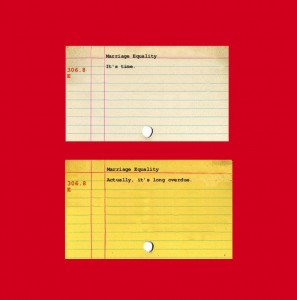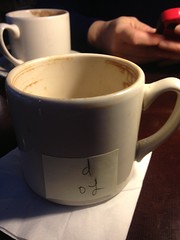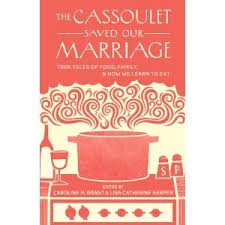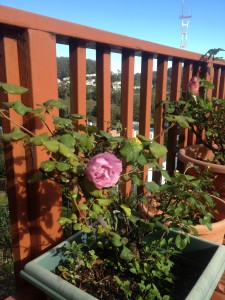If you’re planning to cast your American Library Association ballot this weekend, I offer the following recommendations for Councilor at Large.
The ballot has many people I’d be delighted to serve with. But I am shortlisting the their following candidates for a variety of reasons: I’ve worked with them on Council or other ALA activities,  they have strong, clear positions on ebooks, they contribute to a diverse ALA, and what I can only term “fit.”
Karen Johnson Downing, Martin Garnar, Patricia M. Hogan, Maria Taesil Hudson Carpenter, Richard Huffine, Alys Jordan, Charles Kratz, Dennis LeLoup, Bernard Margolis, Min Chou, Stephen L Matthews, John Pecoraro, Lauren Pressley, and Larry Romans.
Also, I am emphatically for the five-year dues increase schedule (LJ has a good summary), which gives ALA a modest additional revenue stream they can plan on, gives ALA its first dues increase since 2006, and ensures that ALA doesn’t have to cut farther in the bone than it has in the last seven years. (The previous dues increase happened in 1995.) It amounts to $1 – $4 per year per member, which at the highest level, $130, would mean a total possible rise to $150 by 2017.
But back to Council…Â
One Councilor has been raising an issue that can be summarized this way: Council is not effective; Council is ineffective because it is too large; Council is too large because it has too many at-large Councilors.
Having served on Council off and on for nearly 20 years, I would first note that Council has vastly improved since the mid-1990s, when the discussion list was chaotic and it felt like most of Council’s time was spent listening to reports being read out loud in between real-time, agonizing revision of endless GODORT resolutions. Council feels mannerly and focused. It is indeed a big body, and as part of a larger process of discernment, it’s worth asking if Council is too big (however much that evokes the scene from Amadeus where the emperor says, “Too many notes!”).
But if we’re going to look at Council, then let’s look at Council. Here are some facts you might not be aware of.
Council composition: every division and roundtable has Council representation; so ACRL, PLA, GLBRT, etc each have a Councilor. So does every state “chapter.” The very smallest roundtables are represented as a group by one Councilor. There are 100 Councilors at Large, 50 chapter councilors, and approximately 20 councilors representing divisions and roundtables.
State chapters have historically been represented by state library associations. Each state association pays dues, though I was unable to find the dues schedule on the ALA website.
State chapters are independent nonprofit organizations and set their own rules–see ALA Bylaws for more about their relationship with ALA.  As a bit of ALA history that illustrates this independence, the state chapters in the South were only integrated in 1964 when an ALA member, E.J. Josey, authored a resolution that  forbade “Association officers and staff from participating in state associations that deny membership to black librarians.” ALA couldn’t tell the state chapters what to do, but it could tell its own people what it couldn’t do–an adroit use of governance in support of civil rights activism.
State chapter councilors are elected by state chapter members, who are not necessarily ALA members. The state chapter Councilor must of course be an ALA member, but that’s not true of the Councilor’s electorate. I knew this before I began studying Council, as I’ve voted in numerous state chapter elections and have participated in chapter activities off and on between 1992 and 2009, but it didn’t hit home until I began studying Council composition.
Based on its 2012 report to ALA, total membership in the California chapter is under 2,000, placing it barely above the median of chapters that reported membership, even though California is the most populous state by a significant margin. I’ve heard the actual membership is around 3,000, so I’m not sure what to believe. But I’ve been advised that turnout for CLA elections is currently in the 10-20% range, which would be roughly 200 to 600 ballots, depending on the actual membership. Based on known voter behavior, it’s possible even fewer vote for chapter Councilor.
By comparison, the lowest qualifying Councilor at Large in the 2012 ALA election received 1,925 votes, and the highest received over 3,000.
(Sidebar: another thing I never thought about is whether chapters reported to ALA… I just assumed they did. I’m still surprised to see 2012 is the first year of such a report and that little over half the chapters participating in the survey reported their total membership, with close to ten saying they didn’t know how many members they had and a dozen or so more leaving that field blank. Really?)
Though in theory state associations “provide geographic representation” for all librarians, and some state chapters also represent regional ACRL members, many state associations, including CLA, are largely comprised of public librarians and generally focus on issues significant to public libraries.
Locally, this public library focus is evident through CLA’s Board composition, which is largely but not exclusively public librarians, and also through its activities and even its press releases. An announcement on the CLA website that library funding is preserved means really that public library funding has been preserved.
A review of CLA press releases from 2011 underscores this focus. It’s possible that the fate of public university funding has come up for discussion or even vote in CLA, but it would be hard to prove by what’s on the website.
Is it a bad thing that CLA could pretty much be called CPLA?  Like the size of Council, not necessarily. In California, there are separate associations and endeavors, such as CSLA, CARL, and BayNet, that provide regional and statewide services and programs for other types of librarians. CARL has a relationship with ACRL that ensures it has some voice through the ALA ACRL Councilor.
Also, having worked in nearly every type library, I’m aware that public libraries have particular advocacy needs, such as state funding, that fit well within the state association model. So I think of the state library associations I’ve been involved in not so much as a source of regional representation for all types of libraries but as an important structural component for library services and funding largely specific to public libraries.
Right now, the issue of who elects chapter councilors, and the companion issue of regional representation, Â is something easy to gloss over. It’s an antiquated model (I wager the state chapter model had a lot to do with the complexity of travel and communication in the early 20th century), but the size of Council, and the many types of Councilors, ensures a diversity of participation.
But if the “solution” to Council were to shrink its at-large Councilor demographic without any other changes, there would be two results that are not healthy for ALA.
First, public librarians would have a disproportionately larger voice in ALA decision-making, assuming at-large Councilors continue to represent a mix of library types while state chapter councilors would continue to generally be public librarians elected by public librarians.
Second, the strength of the ALA voting electorate would be further diluted by the election of councilors by non-ALA members.  One way to reverse that would be if ALA members paid dues to their state associations in order to be eligible to vote for ALA chapter Councilor candidates in state association elections–or for that matter run for the position. Frankly, spending up to $165 for regional representation feels like a poll tax (and a reminder: the highest rate for ALA dues is $130). It is a poll tax I’m willing to overlook in the current structure, given the historical relationship of chapters to the national association, but again — if we’re going to look at Council composition, then this question needs to be addressed as well.
An alternative, found in some associations, would be for state chapters to organize council representation through super-regions and elect fewer Councilors to ALA. If fewer at-large councilors would improve ALA, the same should hold for chapter councilors. Â This model is found in a number of professional associations. Â I’m unclear this is a good fit for ALA, but it should certainly be on the table.
There are other paths to be considered, such as doing away entirely with chapter councilors and electing regional representatives who are basically at-large candidates running from their home states or regions. I don’t think any of us want that, because we value the historical chapter-ALA relationship. But if we’re opening the door to considering Council composition, then everything needs to be on the table.
But I’d like to move past the issue of Council’s size and at-large representation, and share the  following two recommendations for improving Council.
First, Council should meet four times per year. Right now we are reactive to whatever is “hot” right before the summer and winter solstice. Let’s become an equinox-and-solstice Council. Â (Note: if I’m reading the bylaws correctly, this doesn’t require any “legislative” action other than the ALA president calling a meeting.)
The solstice meetings would be the important face-to-face engagement that establishes community among Council itself. The equinox meetings, which could be easily held through technology such as Gotowebinar and balloting products such as BallotBoxOnline, would enable Council to take action quarterly, and would also allow Council actions to be observed by ALA members, whether or not they attend ALA conferences. Â (And ALA members who do attend conference often have busy schedules that preclude sitting in on Council proceedings.)
This would also allow items to be referred to other units for additional input without essentially tabling the items for half a year.
I firmly believe if more ALA members saw Council in action, more members would appreciate our work. Watching democracy in action is like watching paint dry, but I can affirm that Council proceedings are well-run, thoughtful, and deliberative.
I also believe that online meetings would enhance the democratic nature of Council by enabling members, regardless of their ability to attend conference, to observe Council proceedings twice a year. Â I would even hazard that more members would attend conferences if they had a chance to see ALA governance in action other times of the year.
I furthermore believe that the ability to communicate with Councilors in real-time while issues are being deliberated would strengthen the democratic nature of Council. Â I have found that Twitter conversations during Council have helped me reason through issues and ask questions of the “Tweetlectorate.” Â Chatting, emailing, tweeting, or otherwise engaging with Councilors during procedures is a good thing.
I know that there are complexities to ALA governance to consider, particularly given the fall/spring meetings of ALA units. But I don’t believe these complexities are insurmountable.
Second, and I have been saying this in one form or another for nearly 20 years, Council’s text transcriptions should be streamed in real time to ALA Connect during Council sessions.
ALA already pays to have proceedings transcribed in real time, so that the text of the discussion is broadcast on two huge screens in Council’s meeting room. That’s the expensive part of this activity–the human transcription. I once called the company that provides this to ask what it would cost to stream the text, and I don’t recall the answer, but it was reasonable.
Why not add text streaming so that even at “solstice Council,” busy members can snack on Council proceedings while they do other things, and members who are not at ALA can observe Council? And of course, the text streaming during Equinox Council would be equally available to the busy multi-tasking body politic.
(Note: for the record, I am not at all concerned that ALA members would decide to forgo ALA conferences because they could watch Council at home. Council is important, but we’re just not that exciting.)
Again, as shared in my last post, Bobbi Newman has done a great job discussing the at-largeness issue. I look forward to hearing your thoughts.














